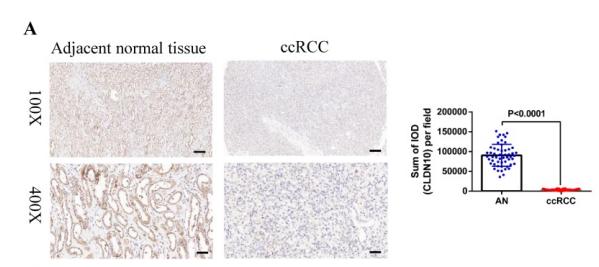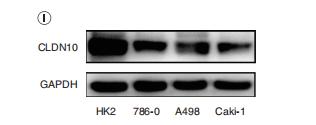Claudin 10 Antibody - #AF0133
| Product: | Claudin 10 Antibody |
| Catalog: | AF0133 |
| Description: | Rabbit polyclonal antibody to Claudin 10 |
| Application: | WB IHC IF/ICC |
| Reactivity: | Human, Mouse |
| Prediction: | Pig, Bovine, Horse, Sheep, Rabbit, Dog, Chicken |
| Mol.Wt.: | 25kDa; 24kD(Calculated). |
| Uniprot: | P78369 |
| RRID: | AB_2833317 |
Related Downloads
Protocols
Product Info
*The optimal dilutions should be determined by the end user.
*Tips:
WB: For western blot detection of denatured protein samples. IHC: For immunohistochemical detection of paraffin sections (IHC-p) or frozen sections (IHC-f) of tissue samples. IF/ICC: For immunofluorescence detection of cell samples. ELISA(peptide): For ELISA detection of antigenic peptide.
Cite Format: Affinity Biosciences Cat# AF0133, RRID:AB_2833317.
Fold/Unfold
Claudin-10; Claudin10; CLD10_HUMAN; CLDN 10; CLDN10; CLDN10 protein; CPETRL 3; CPETRL3; HGNC:2033; OSP L; OSP like protein; OSP-like protein; OSPL;
Immunogens
Expressed in the kidney, eccrine sweat glands and in all layers of the epidermis. In the kidney, it is detected in the thick ascending limb of Henle's loop (TAL) (PubMed:28771254, PubMed:28686597). In the sweat glands, it is expressed in cells from secretory portions, corresponding to the clear cells (PubMed:28686597).
- P78369 CLD10_HUMAN:
- Protein BLAST With
- NCBI/
- ExPASy/
- Uniprot
MASTASEIIAFMVSISGWVLVSSTLPTDYWKVSTIDGTVITTATYWANLWKACVTDSTGVSNCKDFPSMLALDGYIQACRGLMIAAVSLGFFGSIFALFGMKCTKVGGSDKAKAKIACLAGIVFILSGLCSMTGCSLYANKITTEFFDPLFVEQKYELGAALFIGWAGASLCIIGGVIFCFSISDNNKTPRYTYNGATSVMSSRTKYHGGEDFKTTNPSKQFDKNAYV
Predictions
Score>80(red) has high confidence and is suggested to be used for WB detection. *The prediction model is mainly based on the alignment of immunogen sequences, the results are for reference only, not as the basis of quality assurance.
High(score>80) Medium(80>score>50) Low(score<50) No confidence
PTMs - P78369 As Substrate
| Site | PTM Type | Enzyme | Source |
|---|---|---|---|
| S94 | Phosphorylation | Uniprot | |
| Y192 | Phosphorylation | Uniprot | |
| T193 | Phosphorylation | Uniprot | |
| Y194 | Phosphorylation | Uniprot | |
| S199 | Phosphorylation | Uniprot | |
| S202 | Phosphorylation | Uniprot | |
| S203 | Phosphorylation | Uniprot | |
| T205 | Phosphorylation | Uniprot | |
| Y207 | Phosphorylation | Uniprot | |
| Y227 | Phosphorylation | Uniprot |
Research Backgrounds
Plays a major role in tight junction-specific obliteration of the intercellular space, through calcium-independent cell-adhesion activity. Involved in the regulation of paracellular epithelia permeability to ions in multiple organs. It acts as a paracellular ion channel probably forming permselective pores; isoform 1 appears to create pores preferentially permeable to cations and isoform 2 for anions. In sweat glands and in the thick ascending limb (TAL) of Henle's loop in kidney, it controls paracellular sodium permeability which is essential for proper sweat production and renal function.
Cell junction>Tight junction. Cell membrane>Multi-pass membrane protein.
Expressed in the kidney, eccrine sweat glands and in all layers of the epidermis. In the kidney, it is detected in the thick ascending limb of Henle's loop (TAL). In the sweat glands, it is expressed in cells from secretory portions, corresponding to the clear cells.
Can form homodimers both in trans (interaction between CLDN10 molecules in opposing membranes) and in cis (interaction between CLDN10 molecules within one membrane).
The fourth transmembrane region (161-181) is necessary for integration into tight junctions.
Belongs to the claudin family.
Research Fields
· Cellular Processes > Cellular community - eukaryotes > Tight junction. (View pathway)
· Environmental Information Processing > Signaling molecules and interaction > Cell adhesion molecules (CAMs). (View pathway)
· Human Diseases > Infectious diseases: Viral > Hepatitis C.
· Organismal Systems > Immune system > Leukocyte transendothelial migration. (View pathway)
References
Application: IHC Species: mouse Sample: renal
Application: WB Species: Human Sample: renal tubular epithelial cell
Restrictive clause
Affinity Biosciences tests all products strictly. Citations are provided as a resource for additional applications that have not been validated by Affinity Biosciences. Please choose the appropriate format for each application and consult Materials and Methods sections for additional details about the use of any product in these publications.
For Research Use Only.
Not for use in diagnostic or therapeutic procedures. Not for resale. Not for distribution without written consent. Affinity Biosciences will not be held responsible for patent infringement or other violations that may occur with the use of our products. Affinity Biosciences, Affinity Biosciences Logo and all other trademarks are the property of Affinity Biosciences LTD.


